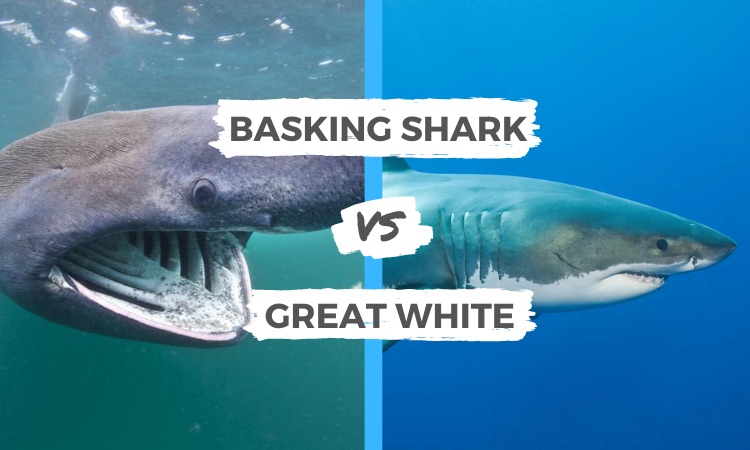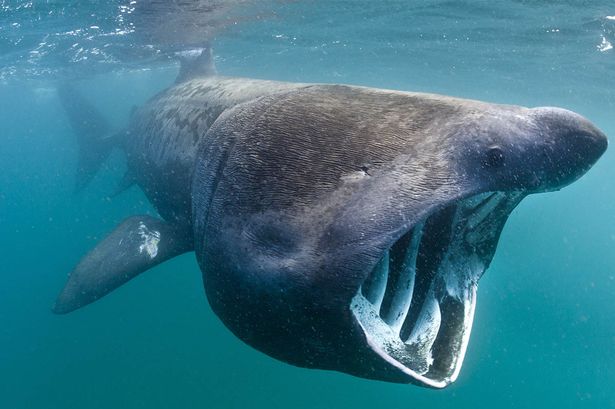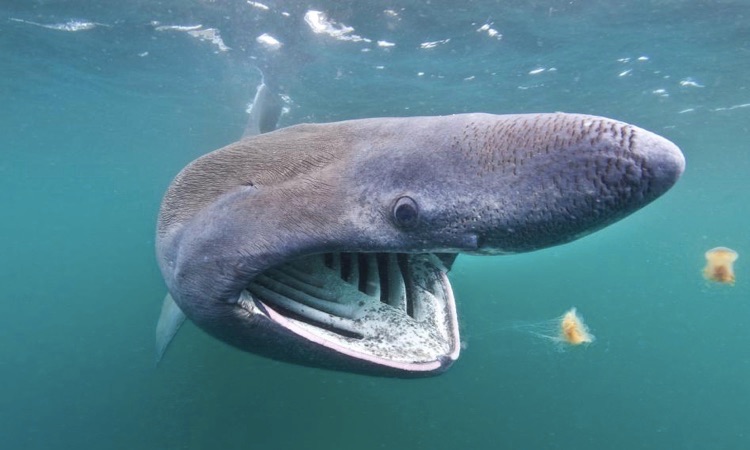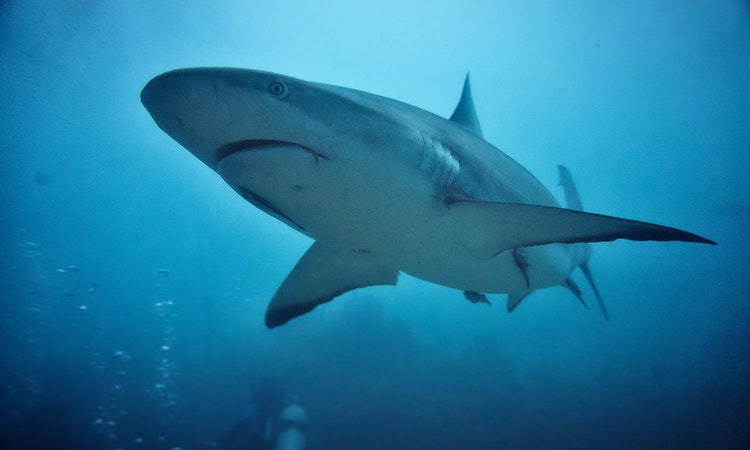This article explores the differences between the basking shark vs great white. The basking shark is far bigger than the great white shark. It is among the few sharks that eat zooplankton (filter-feeding).
The great white shark, on the other hand, is a predator. This implies that it tracks and captures its prey. Seals and sea lions are two of their primary food sources.

Basking Shark vs Great White: Main Differences
The basking shark vs great white are two types of sharks that occur in different parts of the world. Here are the top five most significant distinctions between these two species:
Size
The maximum length of a basking shark is about 26 feet. By comparison, the great white shark can reach a maximum length of about 16 feet.
Appearance
Basking sharks are grey/brown with mottled skin and a huge mouth, similar to great white sharks. They have a duo-tonal head with jagged teeth.
Diet
Basking sharks are filter-feeders that eat tiny fish, invertebrates, and other food. The great white shark is the world’s biggest predatory shark, consuming other sharks, seals, and sea lions when hungry.
Habitat
Basking sharks are found all around the world. They tend to travel thousands of kilometers to feed on plankton. Great white sharks, on the other hand, are restricted to coastal zones and prefer warmer temperatures.
Life Span
The lifespan of a basking shark is typically around 50 years. Whereas that of a great white shark can be up to 70.

Basking Shark
The basking shark is the world’s second biggest fish after the whale shark. The Cetorhinidae family contains just one surviving member: the shark.
Basking sharks are solitary animals that spend the majority of their time alone unless they are congregating around a huge plaice of zooplankton. The name “shark” comes from the way that this fish swims to the surface of the water and reclines in the sun’s warmth.
Quick Facts
- They’re sluggish, like the whale shark.
- They migrate deeper into the ocean during the colder months.
- Because of overfishing, some shark populations are practically extinct in certain regions today.
- The brain of the shark is tiny in comparison to other sharks.
- In some nations, the basking shark has become a lucrative source of food.
- The gestation period for basking sharks is one year.
Appearance
The basking shark is extremely large, growing to a length of 26 feet (still far smaller than the whale shark). Larger than the great white shark, which reaches lengths of 15-16 ft or 5.6-4.9 meters in length.
The basking shark is a large fish with grey-brown skin and markings all over its body. It also has a distinctively large mouth that distinguishes it from other sharks. It has evolved to improve its filtering ability.
It’s one of the few sharks that feed like this (noted below, it’s rather different from the great white shark).
The shark’s unusual snout and distinct caudal fin distinguish it from other fish. Despite its huge size, the great white shark is quite easy to identify because of these features. Although it is the second-largest species of shark, it can sometimes be a frightening sight from the surface of the water.

Habitat
The basking shark can be found in temperate seas all around the world. These sharks travel hundreds of kilometers every month during the year as they seek out the biggest plumes of plankton. They’ve been spotted all over Massachusetts, the Amazon River, the Mediterranean Sea, and other parts of the planet’s seas.
Basking sharks, on the other hand, generally move down to deeper levels during winter months, usually around 3,000 feet or 900 meters.
Diet
The sharks have around 100 teeth in each row of their mouths. This is despite the fact that they are filter-feeding fish. This implies that it opens its mouth and strains its meal through a filtering mechanism.
The basking shark consumes tiny fish and other species of invertebrates in the water. When it swims forward, it opens its mouth and uses its gill rakers. The large gill slits enable the shark to capture a large number of small creatures. The basking shark is one of three sharks that feed this way.
Great White Shark
The great white shark is one of the Earth’s oceans’ most famous creatures. The shark has been portrayed in a variety of films and television shows, often enhancing their aggressive tendencies and suggesting that human beings should be terrified of them.
Despite being seen as one of the animal kingdom’s apex predators, these sharks are far more nuanced and far from the predators that they have been made out to be.
Quick Facts
- Human fishing and activities such as by-catch are considered to be a threat to the species.
- Fisherman catch great white’s in order to sell their fins as they are a delicacy in several countries.
- The great white shark is the largest predatory fish in the world.
- They have a cone-shaped nose and large fins.
- The sharks are not nearly as dangerous to humans as the media has portrayed.
- The gestation period for great whites is 11 months long.
Habitat
The great white shark can be found in almost all coastal waters. They like temperatures between 54 and 75 degrees Fahrenheit with a range of 12 to 24 degrees Celsius. This indicates that they are able to adapt to both temperate and tropical climates.
The greatest numbers of great whites can be found in the Northeast United States and California, Japan, Oceania, Chile, and South Africa. Despite their presence in numerous seas including the Pacific Ocean and Atlantic Ocean, there have been instances of overfishing reducing the great white population.
Off the coast of New England, human intervention nearly destroyed certain species. But due to the flourishing seal populations in Cape Cod, on the same coast, the number of great whites has grown.

Diet
The great white shark is the biggest predatory shark in the world. It consumes everything from other sharks, sea lions, and sea otters to fish. They have been known to consume small whales and sea turtles.
They aren’t frightened by my very bony carcasses, either. They’ve been know to eat the oceanic sunfish, one of the world’s largest boned fish. Human beings are not a part of the shark’s diet, contrary to public opinion.
They surprise their prey before it becomes aware of their presence. According to Brittanica, the initial bite is so powerful that the prey may occasionally fly out of the water and into the air,.
Appearance
The great white shark is one of the most straightforward sharks to identify. It’s not due to any unique characteristics. It is rather because it has been in numerous films and television programs.
The whale shark (Myliobatis glaucus) is a massive fish that can weigh up to 1,150–1,700 pounds. The females are usually larger and sometimes grow to 2,450 lb or 1,110 kg in weight. They’re between 15 and 16 feet long.
The great white shark is said to be the most intimidating shark in today’s oceans. The sharks have a conical nose and big fins that are generally rather hefty-looking. Their tails are crescent-shaped, and their bellies are white. Countershading is the term used to describe this phenomenon.
Many sea creatures have a form of countershading. It allows them to blend in with the brilliant sunshine streaming through the ocean’s surface. Moreover, they can also blend in with the dark water at the ocean’s bottom.


